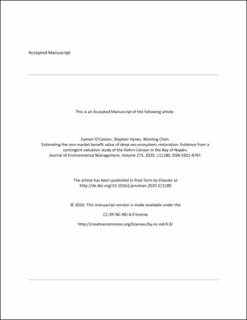| dc.contributor.author | O’Connor, Eamon | |
| dc.contributor.author | Hynes, Stephen | |
| dc.contributor.author | Chen, Wenting | |
| dc.date.accessioned | 2020-09-10T12:36:39Z | |
| dc.date.available | 2020-09-10T12:36:39Z | |
| dc.date.created | 2020-09-08T12:45:57Z | |
| dc.date.issued | 2020 | |
| dc.identifier.citation | Journal of Environmental Management. 2020, 275, 111180. | en_US |
| dc.identifier.issn | 0301-4797 | |
| dc.identifier.uri | https://hdl.handle.net/11250/2677275 | |
| dc.description | Embargo until 21.08.2022. | en_US |
| dc.description.abstract | It is increasingly recognized that restoration actions in marine environments are required in order to deal with continued habitat degradation and to support conservation strategies. Restoration success is judged on the ecological outcomes but with limited resources the magnitude of the societal benefits achieved is an important consideration for policy makers. This study demonstrates how the potential non-market benefit value of a deep-sea restoration project might be assessed. The contingent valuation method is employed to elicit the Italian population's willingness to pay for the restoration of the Dohrn deep-sea canyon in the Bay of Naples. Sample selection models that control for the impact of protest zero bidders on benefit value estimation are compared to more traditional modelling approaches. The results indicate a positive willingness to pay for the restoration of the canyon ecosystem and the importance of accounting for protest zero bidders in contingent valuation studies, especially when the environmental good is unfamiliar to respondents. The paper argues that the inclusion of non-market benefit values is particularly important in assessing the potential for marine ecosystem restoration if a true reflection of the value to society of restoring such habitats are to be correctly captured. | en_US |
| dc.language.iso | eng | en_US |
| dc.publisher | Elsevier | en_US |
| dc.rights | Attribution-NonCommercial-NoDerivatives 4.0 Internasjonal | * |
| dc.rights.uri | http://creativecommons.org/licenses/by-nc-nd/4.0/deed.no | * |
| dc.title | Estimating the non-market benefit value of deep-sea ecosystem restoration: Evidence from a contingent valuation study of the Dohrn Canyon in the Bay of Naples | en_US |
| dc.type | Peer reviewed | en_US |
| dc.type | Journal article | en_US |
| dc.description.version | acceptedVersion | en_US |
| dc.source.volume | 275 | en_US |
| dc.source.journal | Journal of Environmental Management | en_US |
| dc.identifier.doi | 10.1016/j.jenvman.2020.111180 | |
| dc.identifier.cristin | 1828085 | |
| dc.relation.project | EC/H2020/689518 | en_US |
| cristin.ispublished | true | |
| cristin.fulltext | postprint | |
| cristin.qualitycode | 1 | |

